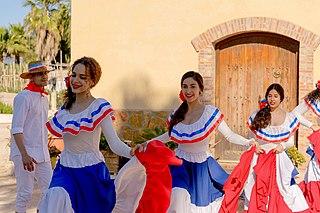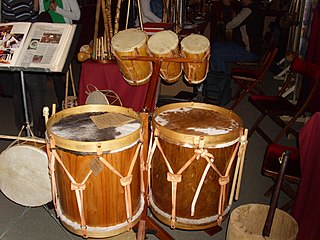
A percussion instrument is a musical instrument that is sounded by being struck or scraped by a beater including attached or enclosed beaters or rattles struck, scraped or rubbed by hand or struck against another similar instrument. Excluding zoomusicological instruments and the human voice, the percussion family is believed to include the oldest musical instruments. In spite of being a very common term to designate instruments, and to relate them to their players, the percussionists, percussion is not a systematic classificatory category of instruments, as described by the scientific field of organology. It is shown below that percussion instruments may belong to the organological classes of idiophone, membranophone, aerophone and cordophone.
The music of Latin America refers to music originating from Latin America, namely the Romance-speaking regions of the Americas south of the United States. Latin American music also incorporate the Indigenous peoples of the Americas. Due to its highly syncretic nature, Latin American music encompasses a wide variety of styles, including influential genres such as cumbia, bachata, bossa nova, merengue, rumba, salsa, samba, son, and tango. During the 20th century, many styles were influenced by the music of the United States giving rise to genres such as Latin pop, rock, jazz, hip hop, and reggaeton.

The music of the Dominican Republic is primarily influenced by Western European music, with Sub-Saharan African and native Taino influences. The Dominican Republic is mainly known for its merengue and bachata music, both of which are the most famous styles of music in the Dominican Republic, and have been exported and popularized around the world.

Timbales or pailas are shallow single-headed drums with metal casing. They are shallower than single-headed tom-toms and usually tuned much higher, especially for their size. They were developed as an alternative to classical timpani in Cuba in the early 20th century and later spread across Latin America and the United States.
A hand drum is any type of drum that is typically played with the bare hand rather than a stick, mallet, hammer, or other type of beater.

Bongos are an Afro-Cuban percussion instrument consisting of a pair of small open bottomed hand drums of different sizes. The pair consists of the larger hembra and the smaller macho, which are joined by a wooden bridge. They are played with both hands and usually held between the legs, although in some cases, as in classical music, they may be played with sticks or mounted on stands.

Merengue is a type of music and dance originating in the Dominican Republic, which has become a very popular genre throughout Latin America, and also in several major cities in the United States with Latino communities. Merengue was inscribed on November 30, 2016 in the representative list of the Intangible Cultural Heritage of Humanity of UNESCO.

The conga, also known as tumbadora, is a tall, narrow, single-headed drum from Cuba. Congas are staved like barrels and classified into three types: quinto, tres dos or tres golpes (middle), and tumba or salidor (lowest). Congas were originally used in Afro-Cuban music genres such as conga and rumba, where each drummer would play a single drum. Following numerous innovations in conga drumming and construction during the mid-20th century, as well as its internationalization, it became increasingly common for drummers to play two or three drums. Congas have become a popular instrument in many forms of Latin music such as son, descarga, Afro-Cuban jazz, salsa, songo, merengue and Latin rock.

Vallenato, is a popular folk music genre from Colombia. It primarily comes from its Caribbean region. Vallenato literally means "born in the valley". The valley influencing this name is located between the Sierra Nevada de Santa Marta and the Serranía de Perijá in north-east Colombia. The name also applies to the people from the city where this genre originated: Valledupar. In 2006, vallenato and cumbia were added as a category in the Latin Grammy Awards. Colombia’s traditional vallenato music is Intangible Cultural Heritage in Need of Urgent Safeguarding, according to UNESCO.

Merengue típico is a musical genre of the Dominican Republic, and the oldest style of merengue. Merengue típico is the term preferred by most musicians as it is more respectful and emphasizes the music's traditional nature. The Instruments that are used are the accordion, bass guitar, güira, conga, and tambora (drum).
Latin percussion is a family of percussion, membranophone, lamellophone and idiophone instruments used in Latin music.

The güira is a percussion instrument from the Dominican Republic used as a percussion instrument in merengue, bachata, and to a lesser extent, other genres such as cumbia. It is made of a metal sheet and played with a stiff brush, thus being similar to the Haitian graj and the Cuban guayo and güiro. Güira, guayo and güiro all have a function akin to that of the indigenous native maracas or the trap-kit's hi-hat, namely providing a complementary beat.
Grupo Aguakate was a Dominican merengue group from 2003 to 2006. The singer, known as Gerpis "Shino" Correa, is sometimes also called by the group name, Aguakate. Shino is also a radio personality on La Mega radio station in New York, being heard by thousands each morning on the show "El Vacilon de la Mañana", and he is also known for his humorous lyrics that use double entendre.

Manuela Josefa Cabrera Taveras, known as Fefita La Grande, is a Dominican accordionist and the most recognized female performer of typical merengue, a more rural variation of merengue, the main musical genre of the Dominican Republic. She is one of the greatest representatives of the "typical genre" along with artists such as Tatico Henríquez, Pedro Reynoso, El Ciego de Nagua, Francisco Peralta, Rafaelito Román, Francisco Ulloa, among others. Her version of the song "La chiflera" is an emblem of typical music.

Domingo "Tatico" García Henríquez, considered one of the best accordionists of merengue tipico, was born in Nagua, Dominican Republic. His career began in the 1960s and the early 1970s. He was known for his skill on the accordion and the addition of new instruments to a standard merengue tipico band.
Candela is a San Francisco-based nine piece salsa music and Latin jazz band created in 1986 under the direction of Uruguayan born lead singer and conga drummer Edgardo Cambón. It consists of piano, bass, trombones, conga drums, bongo drums, timbales, and vocals. "Candela" is one of the "oldest" Salsa Bands, in the Bay Area, having performed consistently an average of 4 performances a month for over 30 years!

The bombo criollo, or simply bombo, is a family of Latin American drums derived from the European bass drum and native Latin American drum traditions. These drums are of smaller dimensions than the orchestral bass drum, and their frame can be made of wood or steel. They can be held vertically or diagonally on the body or a stand. The specific make of the instrument depends on the regional tradition. In Argentina, the bombo criollo is called bombo legüero and played in many folkloric styles. In Cuba, bombos are the largest drums played by the street comparsas in Santiago. In other countries, the term tambora is commonly used.

Luis Alberti was a Dominican Merengue musician, arranger, conductor, and author of significant popular songs such as Compadre Pedro Juan and many others performed and recorded by noted interpreters with diverse backgrounds.

Fogaraté! is the seventh album of the famous Dominican songwriter and musician Juan Luis Guerra. It was released on July 19, 1994. The album mixed a variety of music genres including rural and flolklroic rots of merengue called "Perico Ripao" with elements of African soukus music and Tropical Music such as Reggae with the collaboration of African guitarist Diblo Dibala and Dominican accordionist Francisco Ulloa, along with Son, Bachata and Salsa. Also, the album features a particular, bachata-styled adaptation of the Lacrimosa movement from Mozart's Requiem Mass in D Minor and Guerra's first song fully in English "July 19". Exploring lyrics and themes about magical realism of Latin American literature and commenting on the politics of the Caribbean, for many fans and critics, Fogaraté! is one of his most musically complex album.
Merenhouse, merenrap or electronic merengue,Mambo o Mambo de Calle is a style of Dominican merengue music formed by blending with dancehall reggae and hip hop. The mix of Latin music, house music and dancehall started in NYC in the late 1980s.














